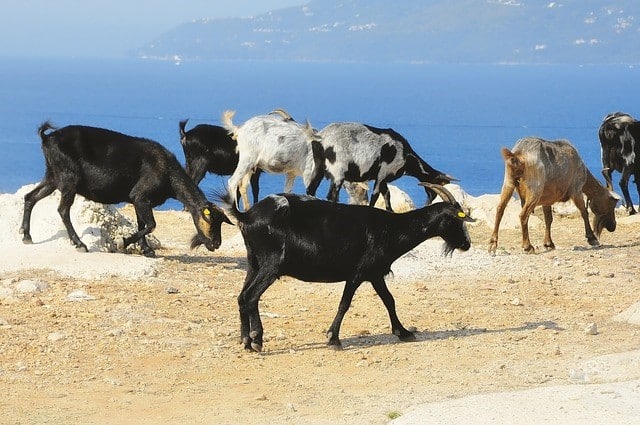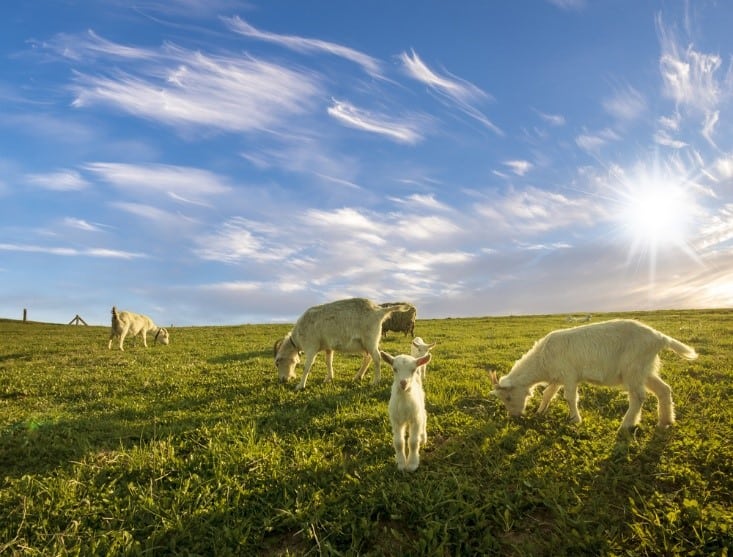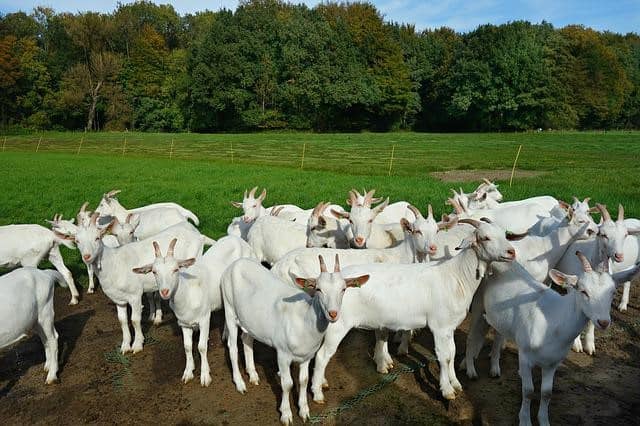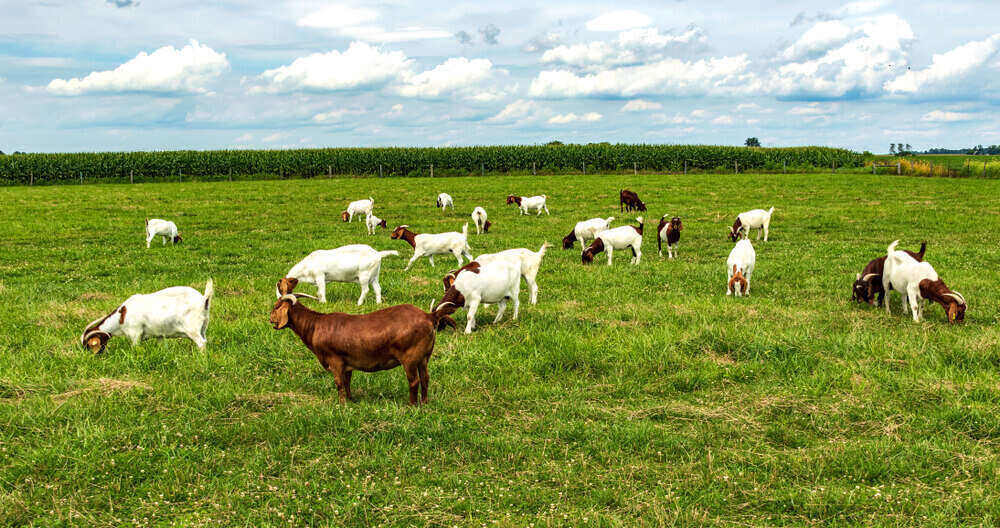Last Updated on August 14, 2024 by Alice Benny
Finding the optimum balance between the size of your goat herd and the available forage is critical for successful grazing management. Regardless of whether your farm is on a continuous or a rotational grazing system, here we will explain how many goats per acre is acceptable.
It is almost always better to have lower stocking rates compared to higher. As much as you don’t want to underutilize the farm’s capacity, it is always better to reduce the number of goats when the space is limited because you might end up straining your land or animals.
Knowing the recommended number of goats per acre is a good place to start in making a decision on how high of a stocking rate to have. This article is dedicated to helping you arrive at this figure based on the specific conditions on your farm.
How Many Goats Per Acre
When determining what is the ideal number of goats per acre, consider the average farm can support approximately six to eight goats per acre of land. This is if the said acre of land has sufficient quality forage to sustain the goats. The capacity to sustain goats can reduce drastically if the quality of forage is low. Higher quality pastures can generally support larger herds, but keep in mind, over-grazing your land will create lower quality pastures.

Other variables, besides the quality of forage, will affect the number of goats per acre your land can sustain. If you wish to expand your herd, some adjustments must be made to ensure the space is sufficient for their grazing and browsing needs. Keep an eye on your land to see if the plants are being over-grazed. If the herd density is too high, good quality plants will start to diminish as low quality plants take their place.
How Big Is an Acre of Land
An acre of land occupies 43,560 square feet, approximately 208 feet by 208 feet. For comparison, a standard American football field is 57,600 square feet, which makes an acre of land three quarters the size of the field.
This illustration might help you determine how much land you have, especially if it is an odd shape. If you are questioning the dimensions of your pastures, you can measure them by hand, or find some useful websites that can use satellite imaging to measure for you.
What to Consider When Determining the Optimal Number of Goats Per Acre
Breed or Size of the Goats on the Farm
The smaller the size of the goats on the farm, the less food they need and the smaller the space required to host them. Size is often dependent on the herd’s average age and breed.
Some goat breeds, like the Nigerian dwarf goats, are remarkably small even when fully grown (the male will only grow up to 23.5 inches tall). Unlike the Boer goat breed, which will grow much larger and require more feed. A Boer goat farmer should limit his herd to six per acre, while you can stock up to eight Nigerian Dwarfs or Pygmy goats per acre.
Use your discretion for the rest of the goat breeds whose sizes fall in the middle, in conjunction with the other considerations mentioned in this article.

Clearing Brush
Another consideration is if you are raising goats to clear brush. If you are utilizing goats for brush management, you can raise more per acre.
This will be the case if you are trying to reduce the amount of vegetation in an area. This is intentional over-grazing.
Climatic Conditions
The climate will affect the goats’ grazing and browsing habits significantly. No single naturally growing forage will keep the goats fed throughout the year. Some plants grow aggressively during summer, while others thrive in winter.
The warm summertime temperatures have high grass and forage production, allowing you to increase the number of goats per acre on your farm. During winter, many grasses become dormant, and you might have to resort to feeding hay and supplements to sustain the herd until the spring or summer.
General Availability of Feed on the Land
You can raise more goats if the piece of land has an array of quality forages. Sufficient levels of grains, grass, and other fodder will keep your herd nutritionally balanced. Goats will thrive where there are overgrown pastures, in wooded areas with low-hanging leaves and thickets. It is even better when the climate supports quick growth for replacement.
Low quality sections of land can be improved by planting quality forage or adopting rotational grazing systems to allow them time to replenish. There is more on rotational farming below.
Factors that Determine Goat Stocking Ratios
These are considerations that cut across all farms, regardless of the richness of their resources, that need to be considered when goat farming.
Eating Habits of the Goat
What do goats eat? Goats prefer browsing to grazing. They enjoy the roughage on the goat farm, and you will find them mostly eating at chin level whenever possible. They will strip leaves from trees and devour shrubs before turning to fresh grass as the last option. Their quality of life is significantly improved if your land can provide their type of forage.
This ability to survive on a wider variety of vegetation enables you to feed more goats per acre than similar livestock like sheep, who are exclusive grazers. Sheep don’t require a lot of separation, though, so more of them can be accommodated per acre than goats in many instances.
We have a similar article on the number of sheep per acre that you can refer to for comparison if you are contemplating between raising sheep or goats. Learn about the difference between sheep and goats.

Susceptibility to Internal Parasites
Sheep and goats have to maintain a distance between them to mitigate the spread of intestinal parasites. Goats need even more space to roam and graze than sheep. Experts recommend that each goat on your goat farm gets their own 10 square feet indoors and 200 square feet outdoors for a healthy existence.
Parasites grow and reproduce in certain environments where goats live, exposing them to possible infestations. Some worms, flukes, and other intestinal parasites grow and reproduce in snails found in stagnant water, while others lay their eggs on wet vegetation.
Others like coccidia thrive in confined spaces and are the most common causes of diarrhea in young goats who are yet to fully develop their own immunity.
The provision of sizeable browsing areas also decreases the instances of ingestion of parasitic eggs from grazing forages.
Allowing ample space for each goat can also allow for dryer pastures. If your stocking rate is too high, the ground may not get time to dry between rain spells, or from the excrement of the animals. Long lasting, stagnant water can be a breeding ground for many detrimental parasites and fungi.
How Many Goats Per Acre of Rotational Grazing
As a goat farmer raising goats for profit, you might opt for the rotational grazing system instead of continuous grazing. This system involves dividing your pasture into paddocks and creating barriers between the paddocks so that the goats can only graze in one of the paddocks at a time.
Rotational grazing allows the grass and the rest of the foliage to regenerate in the resting paddocks so that pasture is available throughout the year. The animal manure is also spread evenly across the land, and the goats get more exercise while enjoying a wider variety of forage and other natural resources. The pastures get a chance to be clean and devoid of parasites when goats haven’t grazed on them for six to twelve months. The downfall to this type of grazing is that you will be having to use more resources to set up paddocks, and you will have to take more time to move the herd around. However, you can typically raise more animals this way.
The ideal maximum number of goats per acre for rotational grazing remains six to eight, but with correct management, can increase. With rotational grazing, you have the ability to allow a pasture to regenerate with no animals grazing it. This also gives you the option to plant more forages in the pasture as it sits empty. This could allow you to raise the stocking rate, as long as the soil quality allows. The advantage of this approach is the risk of overgrazing the pasture is minimized as you will just move the herd to the next paddock when they seem to have depleted their current pasture. Learn what to feed goats to gain weight, especially when raising meat goats.
How Much Land Do Goats Need
The recommended stocking ratio of goats per acre when goat farming is between six to eight if you want them to stay healthy and grow. You can tweak this number when raising goats depending on the size of your goats, your farm’s available resources, and your land management choices.
Learn more about adding goats to your homestead or small farm. Whether you want to raise meat goats such as kiko goats or dairy goats such as nubian goats or toggenburg goats, or a breed such an alpine goat which is good for both milk and meat, there is a breed for you and the acreage you own.
In addition to considering how many goats per acre you can have, consider a space for a goat playground. A play area for them will help keep them active and mentally stimulated. It also helps them with socialization and communication and overall promotes well being and positive behaviors.
Keep reading to learn more about raising goats as livestock:

